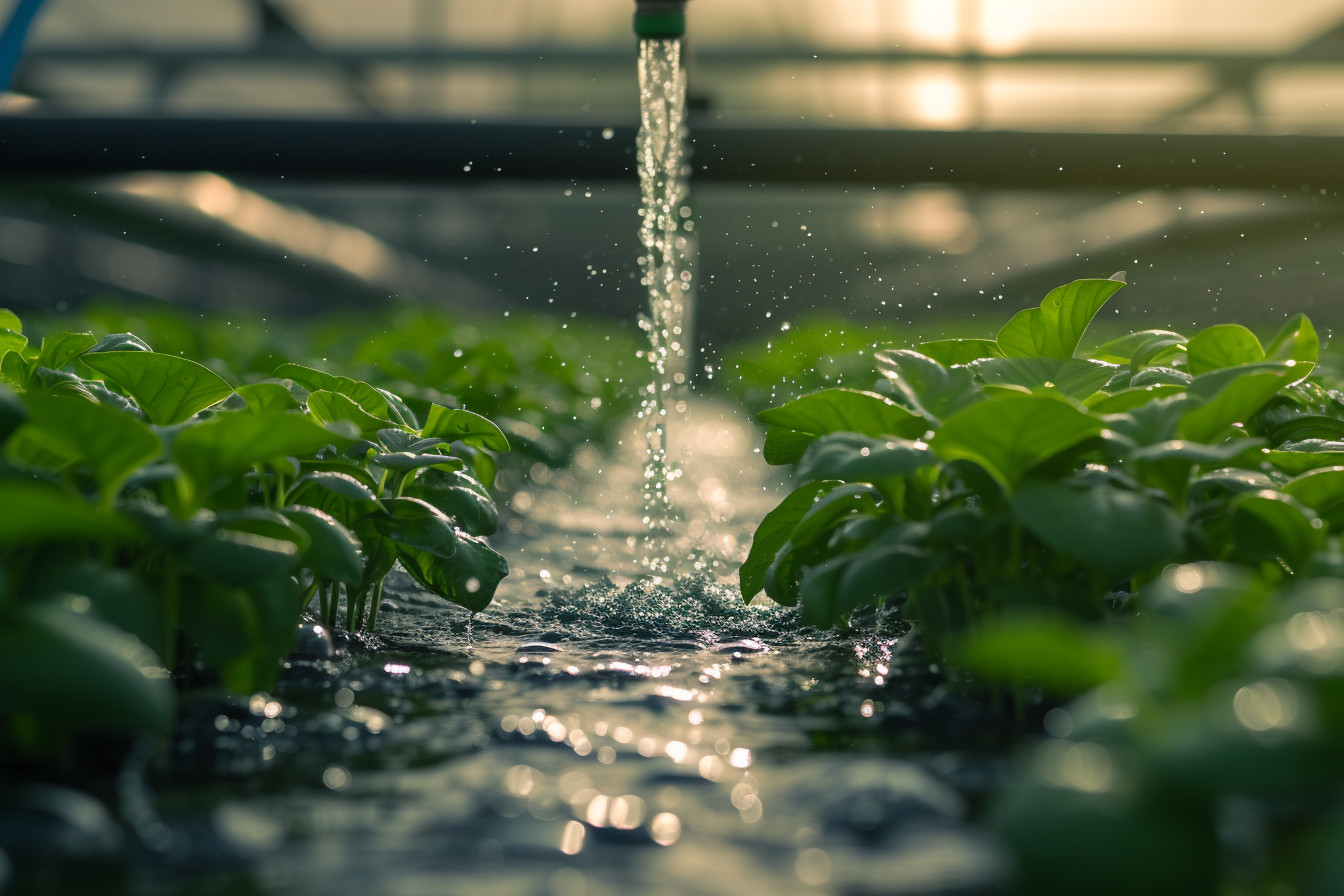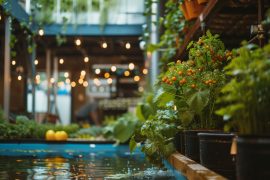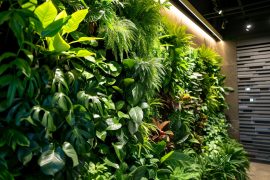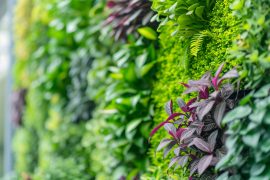Diving right into the heart of modern gardening techniques, vertical gardens are more than just a stylish trend. They represent an ingenious solution for spaces craving greenery without sprawling horizontal space to devote.
What’s often overlooked is this: implementing an effective irrigation system in these lush vertical walls can be both a game-changer and somewhat daunting at times. It’s not simply about making sure your plants stay alive; it’s about using precious resources like water as efficiently as possible.
Think back to those moments when you’ve passed by a vibrant wall adorned with cascading ivies or succulents neatly tucked away in their pockets—therefore feeling that instant rush of tranquility wash over you?
That magic requires meticulous planning behind the scenes centered around one key element: water conservation through efficient irrigation systems designed specifically for gravity-defying gardens.
Imagine tending to such awe-inspiring living art pieces without any worry regarding excessive water use—or worse, neglecting some thirsty greens because they were out of reach or sight!
My journey towards crafting sustainable yet serene urban oases has led me down paths exploring various irrigation methods tailor-made for our leafy friends on high. From drip tubing snaked stealthily behind foliage canvasses to automated misters breathing life into each plant cell, they all aim at redefining efficiency hand-in-hand with eco-consciousness within our cherished garden spaces.
The Importance of Irrigation Systems in Vertical Gardens
When it comes to the magic of vertical gardens, there’s a tranquil beauty that captures our hearts. Picture lush greenery climbing up urban walls, bringing life and serenity into bustling city spaces; it’s like nature is reclaiming its territory one leaf at a time.
But beneath this serene surface lies an intricate dance of efficiency—water droplets navigating through layers upon layers of plants. That’s where irrigation systems step onto the stage.
Imagine waking up each morning to mist gently caressing your indoor garden wall or seeing drops gliding across leaves on your outdoor verdant display after a long day at work. Doesn’t that sound soothing? This isn’t just about visual appeal, though—there are concrete benefits to implementing well-thought-out irrigation schemes for these living art pieces:
- Water conservation: With resources becoming more precious by the day, every drop counts. Automated systems can meticulously calculate and deliver exactly what each plant needs.
- Efficiency: It goes beyond saving H2O; we’re talking about sparing yourself hours hunched over watering cans too! Plus,
This synchronized system embraces modern technology while celebrating ancient concepts found within terraced farms nestled between mountainsides centuries ago—it makes you wonder about how innovative humans have always been when interacting with landscapes around us!
Yet amidst all technicalities, don’t forget: At heart, it’s still YOU nurturing another form of life—caring, connecting deeply as roots entangle seamlessly with elements designed by thoughtful hands.
By sharing anecdotes from personal experiences employing various types among my projects, I’ve glimpsed firsthand those vibrant transformations:
Types of Vertical Garden Irrigation Systems
Digging into the realm of vertical gardens feels a bit like stepping through a portal, where walls bloom with life and concrete jungles drip in verdant hues. When you’re aiming to create such an ecosystem yourself, getting familiar with the right type of irrigation system is crucial.
Yeah, watering cans might do for your potted plants on the windowsill, but when it comes to giving your green wall that lush look, that’s where things get technical, yet incredibly fascinating.
One method I’ve found intriguing—and pretty effective—is drip irrigation. It’s all about efficiency and ensuring each plant gets exactly what it needs directly at its roots without wasting water or fostering excessive moisture around leaves, which can lead to disease.
- A network of tubes snakes across your garden.
- Tiny emitters slowly release water.
This setup means there’s less evaporation compared to traditional methods, so every drop goes further—good news for our planet!
A contender growing (pun intended) and becoming increasingly popular among urban dwellers is hydroponic systems, which are transforming how we think about spacing and soil requirements.
- There is no need for soil; plants grow in nutrient-rich solutions.
- Water circulates throughout using pumps, making reuse simple.
Imagine having fresh herbs year-round while conserving both space and resources—a win-win if ever there was one.
Then there are those who love their tech nearly as much as their plants—the perfect audience for automated or IoT-based systems:
- Schedule and monitor via smart devices
- Real-time adjustments based on weather conditions
Talk about taking control! Plus, watching everything thrive from afar adds to this layer cake icing feeling akin to no other gardening triumph.
| Type | Benefits |
|---|---|
| Drip Irrigation | Minimizes waste by targeting root zones precisely. |
| Hydroponic Systems | Eliminates the need for soil, reducing pest issues and opportunities. |
| Automated IoT-Based Solutions | Custom scheduling aligns watering with climate patterns, saving time. |
Drip-Irrigation Systems for Vertical Gardens
Setting up a drip irrigation system can feel like weaving through the story of your very own vertical garden. It’s about connecting with each plant, understanding its needs, and ensuring it gets just the right amount of water—not too much or too little.
So here’s the scoop: A drip irrigation system is basically this network of tubes that deliver water straight to where your plants need it most—their roots! This method is super efficient because it cuts down on waste by minimizing evaporation and runoff. You’re giving those thirsty plants exactly what they crave without drowning them in love (or, well, water).
Now let me paint you a picture based on some real-world magic I witnessed at this urban oasis, smack dab in the heart of concrete city madness. The owner had set up her vertical gardens using recycled materials and integrated an uber-smart drip setup—we’re talking timers and moisture sensors—making sure everything was automated yet personalized per planter box! Her secret sauce? She kept track:
- Water savings: After switching from hose watering to targeted drippage (yes, “drippage,” my new favorite word), she saw almost 30% less water usage.
- Plant health improvements: Overly soggy soil turned into yesterday’s news as root rot cases dropped drastically.
And guess what else made everyone do double takes besides lush greens and painting gray walls jade?
| Statistic | Before | After |
|---|---|---|
| Maintenance Time | 2 hours daily | 20 minutes with weekly check-ups |
| Resource Efficiency | “Eyeballing” schedules | Automated scheduling Reduced fertilizer use due to precise application |
Aeroponic irrigation systems for vertical gardens
Ever walked through a lush green wall and wondered how each plant looked as if it had its own personal caretaker? Well, they kind of do when you’re looking at an aeroponic system in action. Tucked away behind the scenes, these systems are like the unsung heroes of vertical gardening. They nourish plants from root to leaf with such precision that every drop counts.
Aeroponics is all about air meeting water; think of mist rather than streams or soil saturation. Plants hang out in the air while their roots get intermittently sprayed with nutrient-rich solutions. This might sound a bit sci-fi, but hear me out—this method isn’t just cool science; it’s game-changing for sustainability too!
Let’s break down why aeroponics feels more like nurturing art:
- Water Conservation: These systems use up to 98% less water compared to traditional farming methods.
Efficiency: The direct-to-root delivery means nutrients aren’t wasted; everything goes straight where needed.
Plants love this! With oxygen galore (roots hanging free) and consistent nutrition without overwatering stresses, growth rates often impress even seasoned gardeners.
I remember being skeptical until I saw lettuce doubling in size way faster than my old soil-planted ones ever did.
But what truly clinches the deal are perfectionists seeking a balance between eco-friendliness and productivity. Imagine configuring your little suspended Eden so nearly zero runoff and precious H2O get lost.
Plus, there is a reduction in pests and diseases since no standing waters invite unwanted guests, optimizing space skyward. Instead of horizontal sprawl tapping into dense, vibrant ecosystems, inch-square footage is available. Sounds dreamy, right?
Here are some numbers around comparative savings in moisture:
| Method | Water usage efficiency |
|---|---|
| Aeroponic System | Upwards of 90% efficiency |
| Traditional Soil-Based Gardening | Significantly lower |
One thing, though: don’t mistake simplicity for minimal labor setups. While initial costs can be higher, drilling basics and operating principles pay off in the long run. As someone passionate about both technology and greener futures, this could be an interesting venture!
Benefits of Efficient Vertical Garden Irrigation Systems
There’s something magical about vertical gardens. They’re like living art pieces, transforming bland walls into lush canvases that breathe life into their surroundings. But here’s the thing: They need a bit more TLC than your average garden plot, especially when it comes to watering. That’s where efficient irrigation systems come in.
Imagine not having to worry if every plant is getting its fair share of water or agonizing over water waste because an innovative system has got you covered!
With drip irrigation or soaker hoses tailored for vertical setups, each little green friend receives just the right amount of hydration directly at its roots, reducing evaporation and runoff—super important points considering how precious our H2O resources are!
Saving water isn’t just great for Mother Earth; it also loves your wallet pretty nicely too—who wouldn’t want lower utility bills? And let me throw some eye-opening stats at you: By switching to an efficient irrigation setup for your sky-high greenscapes, folks can see significant reductions in their landscape water use by as much as 50%.
| Water-saving metrics | Traditional Methods | Efficient Irrigation |
|---|---|---|
| Percentage Saved | 0% | Up to 50% |
Not only does this type of system promote responsible resource use, but leaning hard into optimization means plants thrive under conditions perfecto-mundo designed with their minds (sure, it feels a lot better than guesswork!).
Plus, donning my techy hat: modern versions even allow monitoring via smartphone apps, providing real-time control and insights now—that’s smart gardening brought straight through the technology avenue!
And aren’t we all seeking those peaceful moments entwined deeply within nature’s embrace? The tranquility found ambling around after setting up such carefully considered innovations illuminates simple joys bound tightly together both flora and ours—a symbiotic name tagging peace and prosperity alongside sustainable revelations journeyed upon one dripping tap time.
Water Conservation in Vertical Garden Irrigation Systems
Gardening, especially when you’re piecing together something as visually striking and beneficial as a vertical garden, is an absolute delight. But I’ve got to say, figuring out the watering part? That’s where it gets interesting.
So let’s talk about how we keep these gorgeous green walls thriving without being thirsty for too much H2O.
First up, drip irrigation systems are a game-changer here. Imagine each plant getting its own tiny sip of water right at the roots—no waste.
No more spraying everywhere with your hose, hoping some of it actually makes its way to the plants’ roots! Plus,
This method significantly slashes evaporation losses, which normally spike during hot days or windy conditions.
And then there’s this wild idea called hydroponics mixed into our vertical gardens; think soil-less gardening meets tech innovation.
Plants are fed their nutrients through water alone, meaning every drop counts and less goes amiss.
Now don’t get me started on sensor technology; those little gadgets decide whether your garden is parched before even turning on the spritzers save gallons over just having them run non-stop based purely on guesswork (or timer settings from three seasons ago).
- Drip irrigation cuts down on waste by applying water directly where needed.
- Decreases energy use since pumping massive amounts across wasn’t really necessary after all!
Here’s what strikes most people, though:
When they hear “vertical gardening,” their first thought isn’t usually about conserving anything—let alone h20—but once they see these setups rocking only minimum moisture while serving maximum vibes,?
Tips for Optimizing Water Usage in Vertical Gardens
Getting your vertical garden’s water usage just right feels a bit like hacking into Mother Nature’s own resource-saving plans. And why not? With climate change playing spoilsport with rainfall patterns, every drop of water we save is worth its weight in gold—or at least, fresh veggies and blooming flowers.
Let’s kick things off by peeking under the hood—er, soil—to understand how to make our green walls as thirst-efficient as possible. Drip irrigation systems are pretty much the secret sauce here. Picture this: tiny droplets of water are delivered directly to where they’re needed most—the roots! Lesser evaporation and deep root nourishment mean plants need less yet grow more vibrantly.
Selectively stingy but effective—that’s what we’re aiming for by using mulch atop our growing media. This isn’t just any layer; think of it like a cozy blanket that keeps moisture from escaping too quickly while giving weeds the cold shoulder (a win-win if I’ve ever seen one). Plus—and get ready because this part always gives me goosebumps—it maintains an even temperature around plant roots, which encourages healthy growth without excess watering!
Setting up sensors might sound uber-technical, but hear me out—they’re basically little guardians watching over your precious H2O use so you don’t accidentally give your greens a flood instead of a drink. Microsoft Clippy vibes aside (“It looks like you’re trying to irrigate!”), these tools help maintain optimal moisture levels while ensuring not a drop goes wasted. What could be better than having technology do some heavy lifting on behalf of keeping nature thriving?
Lastly, let’s take planning seriously. When choosing plants, go native or drought-tolerant. They know how to party through dry spells, making them perfect dance partners for anyone keen on optimizing their vertical oasis’. Less demanding guests means hosting parties conserves resources all around.
Final Thought
This is the wrap-up of our deep dive into vertical garden irrigation systems. Throughout this journey, I’ve shared a lot about how these nifty setups can both save water and keep your green dreams thriving. It’s been a mix of tech talk, eco-friendly tips, and my own gardening tales—hopefully, you’ve found it as enriching to read as I did writing it.
Vertical gardens are more than just eye candy; they’re smart solutions for urban spaces craving that touch of nature—or really any spot where ground space is at a premium but the sky’s the limit. The crux lies in choosing an irrigation system that aligns with your plants’ needs while keeping resource conservation front-and-center.
Let’s glance over some key points:
- Efficiency isn’t optional—we’ve seen how tailored systems like drip or micro-spray options not only reduce waste but ensure our leafy buddies get exactly what they need.
- Water conservation feels good—knowing you’re doing right by Mother Earth adds another layer of satisfaction to gardening victories.
If numbers speak louder than words for you, here’s something crisp:
| Tech Type | Water Savings: |
|---|---|
| Drip Irrigation | Up to 70% |
| Micro-Spray | Around 30% |
Pretty impressive, huh?
Remember those times when adjusting nozzles felt like defusing bombs? Yeah, me too! But getting past such fiddly bits brings us closer not only to mastering modern agriculture techniques but also to reconnecting on another level with caring for life itself—even if it doesn’t bark or purr back!
The world might be spinning faster day by day, forcing us often onto higher floors above earth, yet through innovations like vertical farming, we forge new links—invincible, almost ethereal—between humanity and soil once walked upon, seldom remembered, now embraced anew from balconies, rooftops, anywhere sunlight dares reach out its warm hand.







